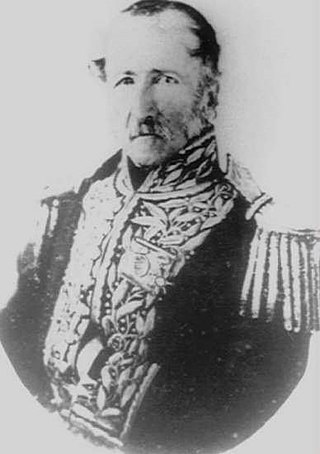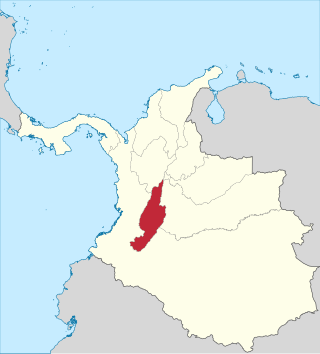
Cundinamarca Department was one of the departments of Gran Colombia. It was part of the Centro District.

Cundinamarca Department was one of the departments of Gran Colombia. It was part of the Centro District.

Department of Cundinamarca is one of the departments of Colombia. Its area covers 22,623 square kilometres (8,735 sq mi) and it has a population of 2,919,060 as of 2018. It was created on August 5, 1886, under the constitutional terms presented on the same year. Cundinamarca is located in the center of Colombia.

Colombia is a unitary republic made up of thirty-two departments and a Capital District. Each department has a governor (gobernador) and an Assembly, elected by popular vote for a four-year period. The governor cannot be re-elected in consecutive periods. Departments are country subdivisions and are granted a certain degree of autonomy.

Neiva is the capital of the Department of Huila. It is located in the valley of the Magdalena River in south central Colombia with a municipal population of 357,392. It is one of the most important cities in southern Colombia, mainly because of its strategic geographical location.

Antonio Amador José de Nariño y Álvarez del Casal, was a Colombian ideological precursor of the independence movement in New Granada as well as one of its early political and military leaders.

Melgar is a Colombian municipality and town in the Department of Tolima, 98 km (61 mi) southwest of Bogotá and 1 hour east of Ibagué, the capital city of Tolima.

The First Republic of New Granada, known despectively as the Foolish Fatherland, is the period in the history of Colombia immediately following the declaration of independence from Spain in 1810 and until the Spanish reconquest in 1816. The period between 1810 and 1816 in the Viceroyalty of New Granada was marked by such intense conflicts over the nature of the new government or governments that it became known as la Patria Boba. Constant fighting between federalists and centralists gave rise to a prolonged period of instability that eventually favored Spanish reconquest. Similar developments can be seen at the same time in the United Provinces of the Río de la Plata. Each province, and even some cities, set up its own autonomous junta, which declared themselves sovereign from each other.

Policarpa Salavarrieta, also known as La Pola, was a Neogranadine seamstress who spied for the Revolutionary Forces during the Spanish Reconquista of the Viceroyalty of New Granada. She was captured by Spanish Royalists and ultimately executed for high treason. The Day of the Colombian Woman is commemorated on the anniversary of her death. She is now considered a heroine of the independence of Colombia.

Manuel de Bernardo Álvarez del Casal was an influential Criollo figure in New Granada at the time of the independence movement. He occupied several important positions in the rebel government. He was also the uncle of Antonio Nariño, forerunner of independence. He served as president of the rebel State of Cundinamarca in 1814.

The United Provinces of New Granada was a country in South America from 1810 to 1816, a period known in Colombian history as la Patria Boba. It was formed from areas of the New Kingdom of Granada, roughly corresponding to the territory of modern-day Colombia. The government was a federation with a parliamentary system, consisting of a weak executive and strong congress. The country was reconquered by Spain in 1816.

The Granadine Confederation was a short-lived federal republic established in 1858 as a result of a constitutional change replacing the Republic of New Granada. It consisted of the present-day nations of Colombia and Panama and parts of northwestern Brazil. In turn, the Granadine Confederation was replaced by the United States of Colombia after another constitutional change in 1863.

The Colombian Civil War began on 8 May 1860 and lasted until November 1862. It was an internal conflict between the newly formed conservative Granadine Confederation and a more liberal rebel force from the newly seceded region of Cauca, composed of dissatisfied politicians commanded by General Tomás Cipriano de Mosquera, its former president. The Granadine Confederation, created a few years earlier in 1858 by Mariano Ospina Rodríguez, was defeated in the capital Bogotá, with Mosquera deposing the newly elected president Bartolomé Calvo on July 18, 1861. Forming a provisional government, with himself as president, Mosquera continued to pursue the conservative forces until their final defeat in 1862. The resulting formation of the new United States of Colombia would have significant cultural and economic consequences for Colombia.

The National Administrative Department of Statistics (DANE) does not collect religious statistics, and accurate reports are difficult to obtain. However, based on various studies and a survey, about 90% of the population adheres to Christianity, the majority of which (70.9%) are Roman Catholic, while a significant minority (16.7%) adhere to Protestantism.
The constitutional history of Colombia is the process of formation and evolution of the different constitutions that Colombia has had since its formation.

Joaquín Paris y Ricaurte was a hero of the Latin American war for independence.
The Republic of Gran Colombia was a former independent country in northern South America, a post-Spanish colonial country that existed from 1819 to 1831. Its initial subdivisions, created in 1820, were revised and expanded in 1824.

States of Colombia existed from February 27, 1855, in the Republic of New Granada and the Granadine Confederation, where they were called "federal states". In the United States of Colombia they were called "sovereign states".

The San Martín Territory was a national territory of the Republic of New Granada (1846-1856) and the United States of Colombia (1866-1886) created on June 2, 1846. The capital was San Martín.

Tolima State was one of the states of Colombia.

Cundinamarca State was one of the states of Colombia. It was created on 15 June 1857 as Estado Federal de Cundinamarca, in 1858 was recognized as Estado de la Federación, and in the constitution of 1863 renamed as Estado Soberano of the United States of Colombia.